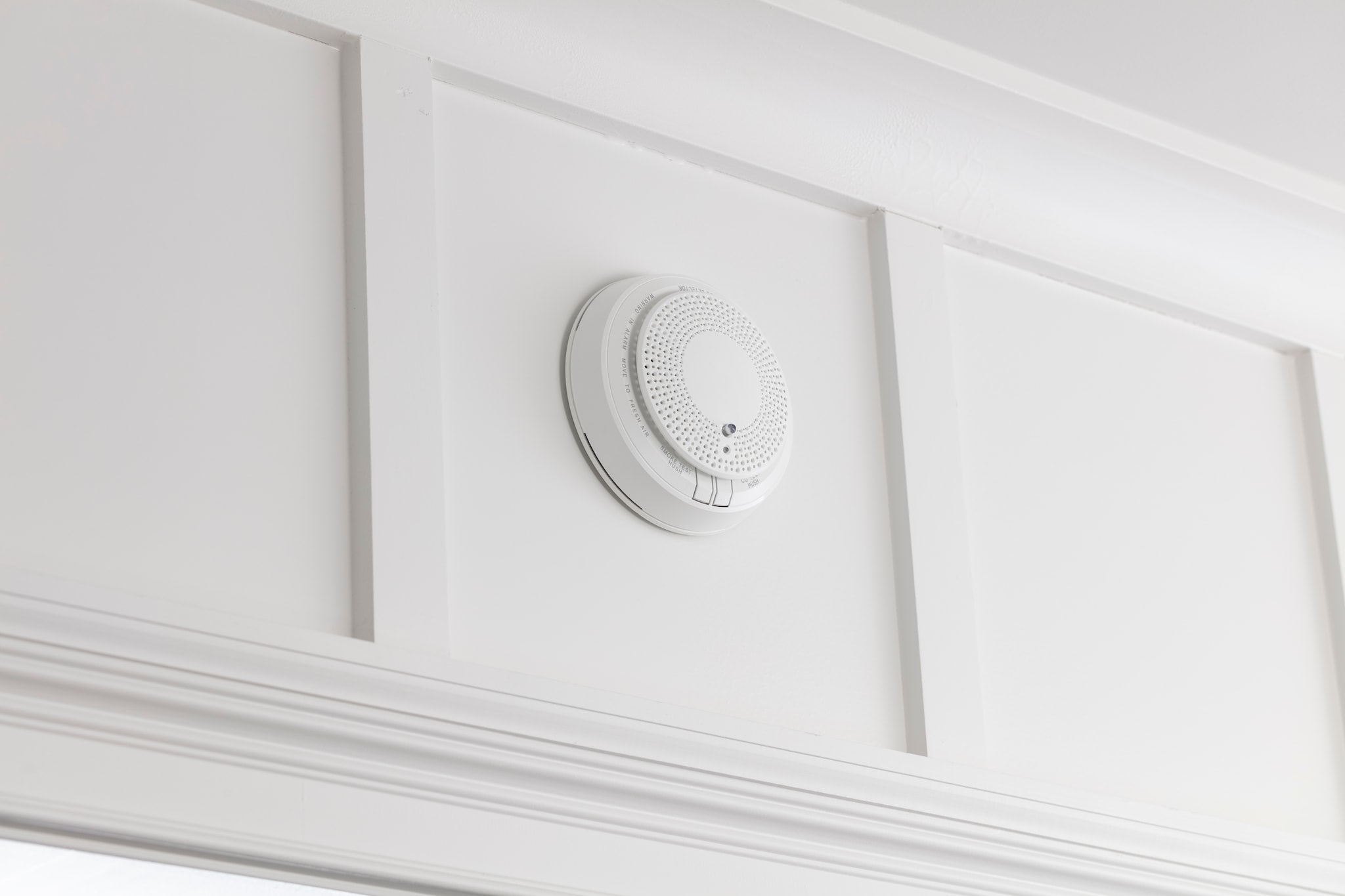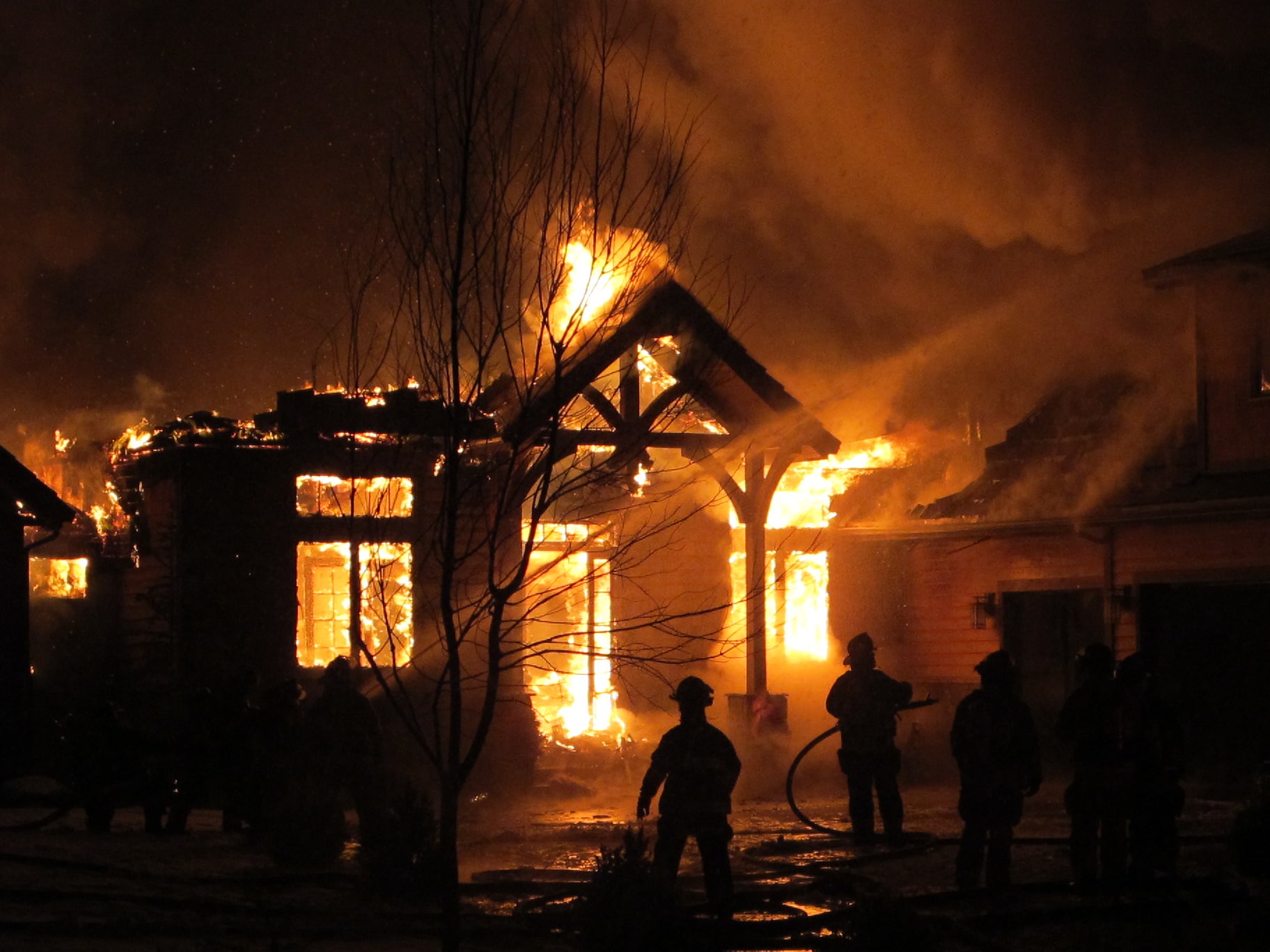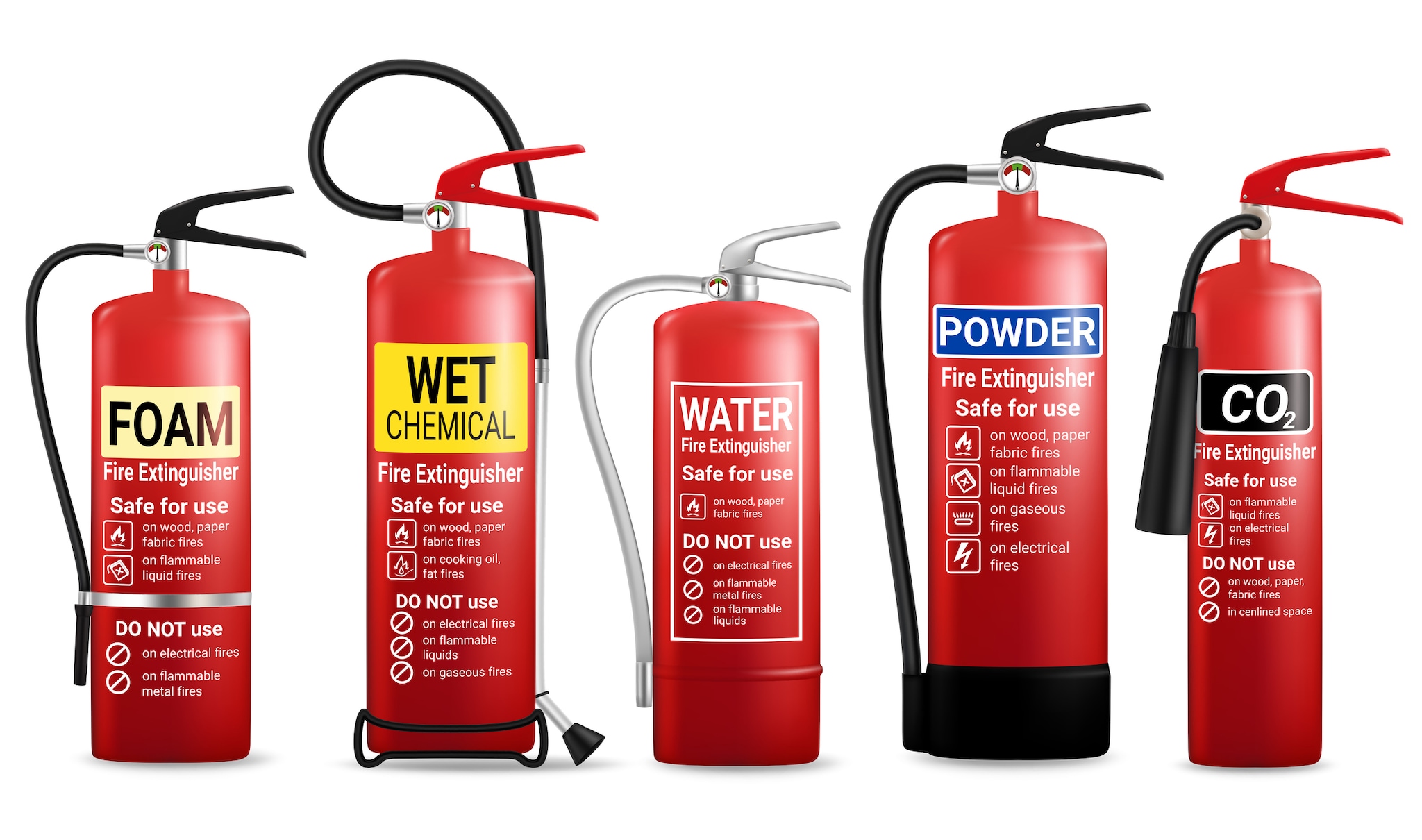House fires can cause catastrophic damage to your home in only a few minutes, leading to heat or smoke damage or even water damage from the fire department. Sometimes a fire is small enough to smother with a fire extinguisher, and sometimes you’ll need to call professionals to fight the flames.
If you ever have any doubt that you can’t smother the flames, you should immediately leave and call the fire department. If the fire is spreading rapidly, you should leave and contact the fire department. If there’s a smoke inhalation risk, you should leave and call 911.
You and your family's lives are more important than the things in your home. You should only attempt to fight a fire if it is small and manageable and you have prior experience handling an extinguisher.
House fire statistics
- Did you know that fires from cooking are the most common home fires? Or that cooking fires are also the number one cause of fire-related injuries?
- A home fire was reported every 89 seconds in 2020.
- In 2020, property damages from fires were around $21.9 billion.
- Twenty-six percent of fires reported from 2015 to 2019 occurred in homes. These fires accounted for approximately 75% of deaths from fires.
- Approximately 40% of deaths from fires happened on properties without fire alarms.
- Homes with smoke detectors reported 55% fewer deaths than homes without alarms.
[Source 1] [Source 2]


How can you prevent damage from a fire?
You should always have a Fire Safety Evacuation Plan.
Practice this plan. Everyone should know where and how to evacuate safely and where they should meet. If your home has burglar bars installed, your children should know how to open or unlock them from the inside. Don’t forget to practice using fire ladders or other safety equipment!
Install smoke alarms throughout your residence.
Smoke detectors can alert you of any smoke in your home and help give you enough time to escape. Smart smoke detectors can notify you and the fire department of a potential fire–even if you’re not home.
Warren “Chip” Knapp, an Interior Firefighter and EMT, said this about smoke inhalation: “You can't last more than a few minutes in a house that's fully engulfed in fire, and it's not the fire that's gonna kill you. It’s the carbon dioxide, and it’s the smoke.”
That’s why proper fire alarm placement is so important.
Have an easily accessible fire extinguisher in your home.
Place a fire extinguisher in an area that leads towards an exit. If you need to fight a fire, make sure your back is to the exit so you can make a quick getaway if you can’t get the flames under control. You should install fire extinguishers where they are visible.
If you’re placing one in a cabinet or it’s obscured, put a sign that explains where the fire extinguisher is located.
Make sure you know how to handle a fire extinguisher before a fire breaks out. Many local fire departments have hands-on training and classes you can take to learn how to manage an extinguisher.
Regularly inspect your dwelling’s heating and electrical systems.
- Create an inspection routine to check that your home’s furnace system isn’t cracked, rusted or falling apart.
- Periodically clean your chimney or furnace.
- If you own space heaters or heating blankets, always check that they’re working correctly.
- If you ever see any frayed cords, replace your electronic devices.
Practice safe kitchen cooking.
Grease fires can happen in any kitchen, so you should always be careful when cooking over an open flame. Keep long hair and dangling jewelry away from the fire. You should also monitor oil and remove your pan once it starts excessively smoking. And don’t forget to turn off the burner when you leave the room!
Where should you mount smoke detectors in the home?
The NFPA requires that you have a fire alarm installed on every level of your home, even in the basement [3].
- In every bedroom or sleeping area.
- Installed outside every room, such as a hallway.
- If you have a level in your home that doesn’t have a bedroom, you should still install a fire alarm. Consider adding one either in the living area or next to the staircase.
- Don’t install alarms near windows and doors or other drafty areas.
- Never paint alarms or add stickers or other decorations to the case.
In the basement: Install smoke alarms on the ceiling at the bottom of the stairway.
In the kitchen: Install fire alarms at least 10 feet from cooking appliances.
General fire alarm placement: Mount alarms high on the walls or ceilings, away from pets or children. If you put the alarm on the wall, make sure it’s no more than 12 inches away from the ceiling (at the highest point of the alarm).
Different Kinds of Fire Extinguishers
Type of Fire Extinguisher |
What it’s Used For |
Class A |
Ordinary combustibles like wood, cloth, plastic or paper. |
Class B |
Combustible liquids, gasses, grease, oil, gasoline, alcohol or propane. |
Class C |
Electrical fires from appliances, tools or wires. |
Class D |
Flammable metals such as titanium, sodium, magnesium or potassium. |
Class K |
Vegetable-based oils and animal fats used in cooking. |
Multipurpose BC |
Flammable liquids, gasses or electrical fires. They are designed to extinguish B and C fires. |
Multipurpose ABC |
Fires that involve ordinary combustibles, flammable liquids, gasses or electrical equipment. They are designed to extinguish A, B, and C fires. |
What to do if there’s a fire in your home?
If a fire breaks out in your home, you should know where you and your family will meet. And remember that smoke rises, so always be cautious when moving through the home.
If you’re unable to leave your home safely, there are a few safety tips you should consider, especially when it comes to being cautious around closed doors.
How do you test a door in case of fire?
1. If smoke is under the door, don’t open it. If you don’t see smoke, carefully test the door with the back of your hand. If it’s hot, don’t open the door
2. If the door isn’t hot, you can test the doorknob with the back of your hand. If it’s hot, don’t open the door.
3. Test the door with the backs of your hands first and never open it with your open palms. If you use your hands, you might burn them and then have difficulty escaping down a ladder.
4. If the door and doorknob aren’t hot and there’s no smoke, open the door slowly.
5. Immediately shut the door if you see any flames or encounter smoke or heat.
6. If there’s no smoke, heat or flames, get out of your home quickly, staying low to the ground.
According to Chip, you should always “stay low and get out. Once you're out, don't go back in.”
What to do if the doorknob is hot?
If the doorknob is hot, don’t open the door. If you’re on the ground floor, escape through the bedroom window and immediately call 911. If you can’t escape, seal off the doorways and vents from smoke. Fill in any cracks under the doors with towels or linens. If you’re not on the ground floor and there’s a window nearby, you can signal for help with a flashlight.
Reported Home Structure Fires by Incident in 2020
|
Number of |
Number of |
Number of |
Amount of |
Home Structure Fires |
356,500 |
2,580 |
11,500 |
$8,400 |
One- and two-family homes (including manufactured homes) |
270,500 |
2,230 |
8,600 |
$6,771 |
Apartment or other multifamily housing |
86,000 |
350 |
2,900 |
$1,629 |
Other residential structure fire |
23,000 |
50 |
400 |
$303 |
Source: Fire Loss in the United States During 2020, National Fire Protection Association® (NFPA®), September 2021.
What to do if there’s a fire in your apartment or condo?
A little preparation can go a long way in helping you prevent injuries during a fire in an apartment or condo.
- Have a Fire Plan in place and practice what you and your family would do if a fire breaks out.
- Know where the nearest exits, stairs or fire escape is.
- Know your building’s evacuation plan.
- Install a fire alarm in every bedroom or where a guest might sleep.
- Ensure that your smoke alarms work. If you’re experiencing issues with your alarms, let your building manager know.
- If you see a broken fire extinguisher, smoke alarm or emergency exit sign in the lobby or hallways, alert building management.
If you can alert the other residents on the way out of the building, do so. Don’t forget to pull any fire alarms you see on the way out.


What to do if your house is on fire?
We’ve compiled a few tips for homeowners to follow to help prepare you and your family for a potential fire.
- Create a Fire Plan with your family and practice different escape routes in the house. You also want to plan fire escape practices when least expected, so you have a chance to practice different escape scenarios.
- Place fire alarms on every level of your home, inside sleeping areas, hallways, at the top or bottom of the stairs, and near the kitchen.
- Don’t forget to test your smoke alarms at least once a month and replace the battery once a year. If you cannot replace the battery, you may need to replace the smoke detector. Follow the manufacturer’s instructions for details.
- If you have a multi-level home, you might want to purchase escape ladders.
- Chip suggests that you have fire ladders on upper floors and make sure your teens and older family members practice using them since they can be challenging to maneuver during a fire. “It's swinging around, and it's not like a ladder, like you and I would think about a ladder. It's a chain.”
- Ensure burglar bars have an easy-access opening from the inside and teach your children how to unlock these mechanisms.
Some fire safety do’s and don’ts for homes and apartments
Do:
- Check doorknobs before opening any doors.
- Grab your keys on the way out, if possible. If you encounter fire or smoke in the hallways or stairs, or the building exit is blocked, you may need to backtrack to your apartment.
- Close any door that you open to help keep the fire contained.
- Stay outside until firefighters tell you it’s safe to go back inside.
Don’t:
- Open a door before first checking that it’s cool. Opening a door could feed the flames more oxygen.
- Many elevators are programmed to return to the lobby and stay there during an emergency, so you should avoid trying to use them.
- Prop open an exit or stairway doors, which could spread the fire more quickly.
- Go back inside a burning building for any reason. Let firefighters know if you suspect someone is still inside and where you think they are.
- Break a window to escape, as this could fuel the fire with more air and increase its duration.
How do you use a fire extinguisher?
NFPA has a handy acronym to help you remember how to use a fire extinguisher: P.A.S.S [4].
Start spraying the fire from a safe distance away and only move towards it as the blaze falters and goes out.
Pull the ring/safety pin while pointing the nozzle away from you and towards the fire.
Aim towards the base of the fire, not the top or middle, so that you can stop the fire at its root.
Squeeze the handle, carefully releasing the foam towards the base of the fire.
Sweep the nozzle from side to side.
Once you’ve sprayed the fire, keep away from it and ensure it doesn’t re-ignite. If it’s out for good, leave the area and allow it to ventilate. Lingering fumes or smoke can be dangerous for your health.
Don’t forget to call 911 so they can clear your home and make sure there isn’t any hidden damage.
How long does it take to recover from a house fire?
House fire can blaze into a destructive force within minutes, causing costly damage in a short time. You’ll have to contend with possible fire, smoke, heat and even water damage. And don’t forget that anything the fire didn’t damage may still need a deep clean.
Firefighters may need to break in through a window or door or cut holes into the walls to ensure the fire is out. And on top of the structural damage, there’s also the mental toll of losing your home and possessions.
So what sort of things should you do once the fire is out?
- There are services you can contact if you need help with housing, food and clothing, including the American Red Cross [5].
- You should call your home insurance agent. You can reach out to local organizations or charities if you’re uninsured.
- Let your landlord know there’s been a fire if you’re a renter, or contact your mortgage company if you own the home.
- Contact utility companies (electric, gas, water, internet).
- If some important documents didn’t survive the fire, you might need to apply for new ones.
- Don’t forget to take care of your emotional needs, too! Speak to local churches, community groups or nonprofit counseling centers.
- Wait until your local fire department says your home is safe to enter before retrieving anything.
Do you get money if your house burns down?
Many homeowners insurance policies cover fire damage and items destroyed in house fires. A typical insurance policy covers dwelling insurance, detached or other structure insurance, and personal property insurance.
Dwelling insurance covers the home and any connected structures like a garage or porch, but not the belongings inside the home. Dwelling insurance can help you rebuild your home and help cover costs if you have to live elsewhere while workers reconstruct your home.
Detached structure or other structure coverage covers other buildings or other structures on your property that aren’t attached to your home. This could include fences, garden sheds, detached garages, or even a dock.
Personal property covers belongings that the fire destroyed. It includes appliances, clothing, sporting goods and furniture.
Homeowners insurance does not cover intentional fire-setting in your home.
Help protect your home and family from fire with ADT.
A fire detector can be the first line of defense for sensing smoke in your home. ADT’s professional monitoring center calls you and sends help if they can’t get a hold of you--whether you’re home or not.
Get fire detection and rapid response 24/7 with ADT.
Frequently Asked Questions About Carbon Monoxide
Can you get sick from a house fire?
Smoke inhalation can affect the body negatively, from burning eyes and a runny nose to irritating your lungs. If you have lung or heart problems, your symptoms could only worsen.
Can you sleep in a house after a fire?
Yes, it’s dangerous to sleep in a house after a fire. Even small fires contain soot and smoke particles, which linger in the home. You should, therefore, wait until the fire department says it’s safe to return to your home before sleeping there again.
How common are house fires?
According to the NFPA, the U.S. fire department responds to 346,800 home fires annually. Cooking fires are the leading cause of both home fires and injuries.
Resources:
[1] https://www.nfpa.org/News-and-Research/Data-research-and-tools/US-Fire-Problem/Fire-loss-in-the-United-States
[2] https://www.nfpa.org/News-and-Research/Data-research-and-tools/Detection-and-Signaling/Smoke-Alarms-in-US-Home-Fires
[3] https://www.nfpa.org/Public-Education/Staying-safe/Safety-equipment/Smoke-alarms/Installing-and-maintaining-smoke-alarms
[4] https://www.nfpa.org/Public-Education/Staying-safe/Safety-equipment/Fire-extinguishers
[5] https://www.redcross.org/find-your-local-chapter.html
Related Articles:


